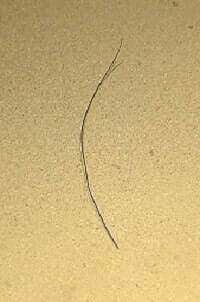Ever since I turned 40, each year I notice more of my eyebrow hairs growing longer and asymmetrically. Besides bushier eyebrows, every so often, I also get a fairly long new ear hair straggler. My beard also grows much faster each year. Most likely, taking low-dose oral Minoxidil for scalp hair loss also makes my facial hair a bit denser and lengthier. However, I think this situation is mostly genetic since my body hair has increased consistently since my early 20s.
On a related note, several decades ago I noticed in real life that men with excessive body hair tended to go bald faster and more extensively. Especially those who had substantial amounts of back hair (which I saw at gyms and pools). I would not be surprised if at least 80 percent of people with a ton of back hair are also balding excessively.
I Grew a Two-Inch Eyebrow Hair

Last week, while working at my computer, I suddenly noticed one of my eyebrow hairs jutting out proudly. I pulled it out, and right away I knew that it was the longest hair that my eyebrows had ever produced. I measured it after straightening it out, and it came in at just about 2 inches in length.
This might not sound like much, but the average young man’s eyebrow hair grows just 0.4 inches (1 centimeter) long before shedding. And many men have very sparse eyebrows that do not get bushier with age.
While the anagen (growth) phase of the hair follicle life cycle of my remaining scalp hairs keeps getting shorter, the anagen phase of my eyebrow hairs keeps increasing. Normally, the anagen phase of scalp hair (in a non-balding person) is 2-6 years, while that of eyebrow hair is just 1-2 months. And when I am 60, I assume that my ear hairs will also miraculously extend their anagen phase to new records each year.
Although this post is focused on men, it should be noted that many women lose a large portion of their eyebrow hairs by the time they hit retirement age. Some even try to use eyelash lengthening drug Bimatoprost (Latisse) on their eyebrows.
Guinness World Records for Body Hair Length
While writing this post, I got curious about the record for the world’s longest eyebrow hair. Lo and behold, I found that the Guinness Book likes measuring various types of body hair world records. Some highlight are presented below.
In 2016, an 81-year old Chinese man Zheng Shusen broke the world record for longest eyebrow hair. His came in at 19.1 cm (7.5 inches).

In 2007, Guinness awarded the world record for longest ear hair to Anthony Victor of India. The groundbreaking ear hair measured 18.1 cm (7.1 inches).

In 2022, Guinness awarded the world record for longest beard hair in a living male to Sarwan Singh of Canada. In fact he has held this record since 2008. His lengthiest beard hair was measured at 2.54 meters (8 feet 3 inches).
Last and the only one of these examples that I find enviable: the world record for longest scalp hair in a living person according to Guinness went to Smita Srivastava from India in 2023. Her luscious locks hit 2.36 meters (7 feet 9 inches) in length.
It is interesting that the beard hair record man has longer hair than the scalp hair record woman. No wonder that beard hair is considered to be the best hair when it comes to body hair to head hair transplants. The only other suitable body hair that can be transplanted to the head is chest hair according to most hair transplant surgeons. Do note that both beard and chest hair have different texture and curliness in comparison to scalp hair.
Body Hair Type and Anagen Duration
Different types of body hair have different anagen growth phase duration periods. Healthy scalp hair in most young men has an anagen phase that lasts from 2-6 years. The onset of male pattern hair loss obviously makes this phase go haywire. A lot of hair loss treatments are geared towards prolonging the anagen phase.
Most types of body hair have a significantly shorter duration anagen phase. The below table uses data from the following paper as well as from Dr. Arvind Poswal’s Body Hair Transplant Textbook and Atlas.
Eyebrow hair has a growth phase of just 1-2 months. So it can never hit 2 inches in length unless the growth phase changes like mine once you hit middle age. Chest hair (not in the table) has a similar anagen phase duration to scalp hair.
| Body Hair Type | Anagen Duration | Anagen Percentage | Telogen Duration |
| Scalp | 2-6 years | 85 | 3-4 months |
| Eyebrow | 4-8 weeks | 10 | 12 weeks |
| Beard | 1 year | 60 | 10 weeks |
| Moustache | 16 weeks | 55 | 6 weeks |
| Trunk | 16 weeks | 30 | 12 weeks |
| Axillae | 16 weeks | 30 | 12 weeks |
| Pubic | 16 weeks | 30 | 12 weeks |
| Legs | 16 weeks | 20 | 24 weeks |